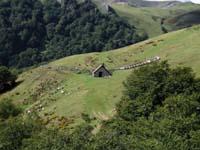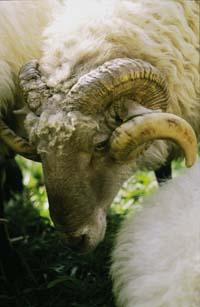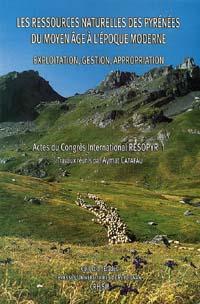Law passed in the Pyrenees: survival
2006/01/01 Galarraga Aiestaran, Ana - Elhuyar Zientzia Iturria: Elhuyar aldizkaria

From the Middle Ages to the Modern Age, researchers from the RESOPYR group want to know how the inhabitants of the Pyrenees exploited their natural resources. For this purpose, as for any other place and time, two types of sources have been used: on the one hand, the documents of that time have been investigated and, on the other, the tracks have been searched and analyzed. Thus, little by little the pieces have been obtained and the puzzle is more and more complete.
Researchers do not have an easy task: many documents are lost or many things have not been collected in the documents and the tracks are not as abundant as expected. In addition, they are difficult to interpret and, in some cases, they have had to create the own methodology of fingerprint analysis, such as the method of research of grasses throughout history in Catalonia.
However, it is quite clear what were the main forms of exploitation of natural resources in those times: livestock, wood exploitation, manufacture and manufacture of lime, mining... According to places and times, one activity or another gained strength; for example, in times of war the forest sector predominated, since the army needed large trunks and straight to manufacture ships. In this case, the almadías descended from the rivers both to the Cantabrian and to the Mediterranean.
In other times, however, grazing gained more than wood and then the forests were burned to create pastures for the sheep. Where there were many minerals, it could be dedicated to mining and, of course, it took advantage. All this with hunting, fishing and the fruits they collected.
Earned wealth wealth
In general, livestock farming has been the simplest way to exploit the area in which times and places have been developed, being therefore the main activity for centuries. We must take into account the XVI. Until the twentieth century in Europe there was no potato or corn. These plants adapt well to the lands of the mountain, while the cereals do not grow well. For this reason, with few exceptions, agriculture has not had strength in the Pyrenees.

The documents also reflect the importance of livestock. For example, there is evidence of the amount of cattle heads they had in the monastery of Leyre. At the end of the twentieth century. However, one of the richest was that of Roncesvalles; the XII. In a document of the twentieth century it is explained that they had a thousand pigs and cattle, and that the grazing rights reached Aralar and the coast of Gipuzkoa.
On the other hand, the documents indicate that citizens did not pay taxes in flour, oils or wines, but in whim or cow. In other documents, the rights of grazing in certain pastures are mentioned or the obligation of payment by transhumancia is specified in the routes of trashumancia. Hence it follows to what extent the life of the people of the Pyrenees for centuries was based on livestock.
In fact, they removed from the animals almost everything they needed to live: leather, wool, meat, milk, cheese... These products were the currency they used to buy wine, bread and oil.
Depending on the local vegetation, one type or other of cattle predominated. In some areas a closed forest of acorn predominated, ideal for the cultivation of pigs, cows and mares. On other occasions, forest trees did not bear usable fruit for cattle, so the trees were cut off, especially if the forest was near a river that facilitated transport. The wood was destined for the construction or shipbuilding and, in the cleared place, a meadow was created. These places were appropriate for the growth of sheep.
Among the whites, black sheep
Political-economic decisions also influenced the type of cattle growing. For example XIV-XV. For centuries, grazing acquired a great force in Castile, driven by the international and interior market. The sheep became axis of the economy and a powerful association was created that controlled the grazing, Mesta. It regulated the routes and dates of the trashumancia. The goal was to avoid problems with farmers in sheep passage areas.

In Aragon, for example, everything was well defined. With the first snow, the cattle should descend down, to the valleys or, as in the documents, to "Spain", and the day was the first of November. In spring, on May 16, the cattle ascended to the superior pastures.
Despite the fact that transhumanity already existed, at that time it totally conditioned the life of many peoples. The herds of southern Spain had to go north in summer in search of grass. In the Pyrenees many forests are burned to create pastures for the sheep, and orders are collected in the archives.
However, there were numerous disputes in the obtaining of meadows, as evidenced by the agreements of use of certain grasses. Sometimes, these agreements were international, as they were held between people on both sides of the border.
This activity lasted for centuries, in some places with greater importance than in others, and according to times, sometimes with more strength and others weaker. But, both through the documents and the footprints, there is no doubt that the livestock had a great weight in the life of the Pyrenean people.
Underground treasure trove

The subsistence economy was based on livestock, but also on agriculture and industry. Each house had its own orchard surrounded by stones to prevent the entrance of the cattle. They made cereals - millet, rye and some wheat - and pods. The mountain lands are not fertile, which forced to burn and rotate the forests, but agriculture did not earn much.
But they not only acted on the ground, but also on the ground, where there were possibilities. Thus, in the Pyrenees there are several mines. The abundance of iron in the Atlantic Navarre caused the mining activity to be important and continuous. In the vicinity of the mines the metallurgical industry was developed, as is the case of the Orbaitzeta weapons factory.
Other minerals are less abundant. In Benasque, for example, silver came out of antiquity; in Navarre a little silver and copper was also extracted, but it was very little compared to iron. Being exceptional cases it is not easy to find documents and clues about them. For example, to investigate the silver mine of Urrobi, a report made in 1340 by Paolo Girardi has helped them greatly. Girardi was a master of Florentine mines who, at the request of the kingdom of Navarre, made a report on his mines. That yes, as he himself acknowledged, he worked "without staining his hands." Finally, due to the lack of services, the king of Navarre decided to resolve the contract. Besides this report, there is not much documentation.
In some cases, therefore, it is difficult to draw conclusions. However, it was not sweet to live in the Pyrenees in those centuries of the Middle Ages to the Modern Age. If it is still not easy today, in those times they only had natural resources to survive, and studies show that they took full advantage of each resource: stone, forest, water, field… to nature.






